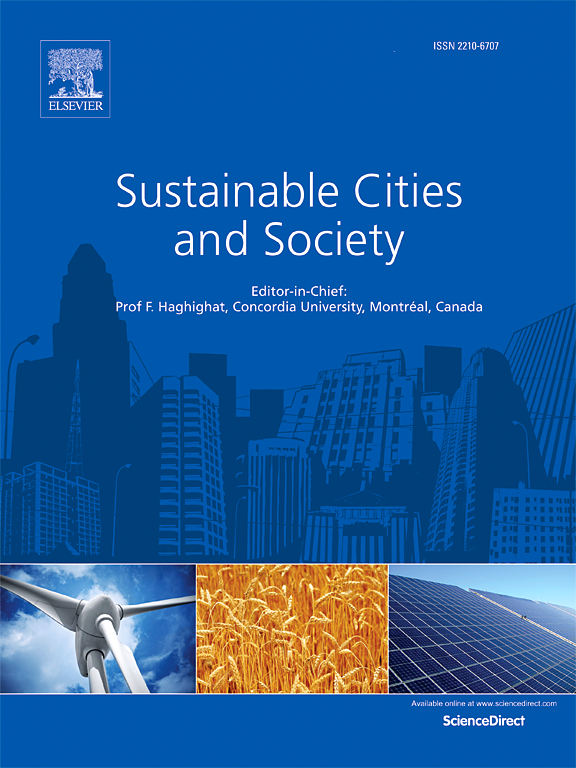Novel spatiotemporal nonlinear regression approach for unveiling the impact of urban spatial morphology on carbon emissions
IF 10.5
1区 工程技术
Q1 CONSTRUCTION & BUILDING TECHNOLOGY
引用次数: 0
Abstract
Understanding the impacts of urban spatial morphology on carbon emissions is crucial for promoting sustainable urban development. However, traditional models have limitations when analyzing complex spatiotemporal heterogeneity and nonlinear relationships. Therefore, we proposed an Integrated Spatiotemporal Nonlinear Regression (ISTNR) model to explore the complex relationship between urban spatial morphology and carbon emissions. This model combines Geographically and Temporally Weighted Regression (GTWR) to capture spatial and temporal dependencies, the Random Forest (RF) model to address nonlinear relationships, and the game theory-based Shapley Additive Explanations (SHAP) tool to enhance the interpretability of the results. The data encompassed urban morphology and carbon emissions across specific regions and periods, and the robustness and adaptability of the model were validated in various urban morphology environments. The ISTNR model demonstrated significant superiority over traditional regression models, achieving an R² of 0.924, a substantially lower MSE (18.06×106), and higher predictive accuracy and stability in complex urban environments. Additionally, bootstrap uncertainty analysis indicated that the model's prediction intervals were relatively narrow, suggesting low prediction uncertainty and high stability. The SHAP analysis quantified the specific contributions of various urban morphological features to carbon emissions, further revealing their mechanisms impacting emission predictions. This study presents an effective quantitative tool for urban planning and carbon emissions control, offering practical support for future urban policymaking.
新型时空非线性回归方法揭示城市空间形态对碳排放的影响
了解城市空间形态对碳排放的影响对促进城市可持续发展至关重要。然而,传统的模型在分析复杂的时空异质性和非线性关系时存在局限性。为此,本文提出了一个时空非线性综合回归(ISTNR)模型来探讨城市空间形态与碳排放之间的复杂关系。该模型结合了地理和时间加权回归(GTWR)来捕捉空间和时间依赖性,随机森林(RF)模型来解决非线性关系,以及基于博弈论的Shapley加性解释(SHAP)工具来增强结果的可解释性。数据包含了特定区域和时期的城市形态和碳排放,并在不同的城市形态环境中验证了模型的鲁棒性和适应性。与传统的回归模型相比,ISTNR模型具有显著的优势,R²为0.924,MSE显著降低(18.06×106),在复杂的城市环境中具有更高的预测精度和稳定性。此外,自举不确定性分析表明,模型的预测区间相对较窄,预测不确定性低,稳定性高。SHAP分析量化了各种城市形态特征对碳排放的具体贡献,进一步揭示了它们影响排放预测的机制。该研究为城市规划和碳排放控制提供了有效的量化工具,为未来的城市政策制定提供了实践支持。
本文章由计算机程序翻译,如有差异,请以英文原文为准。
求助全文
约1分钟内获得全文
求助全文
来源期刊

Sustainable Cities and Society
Social Sciences-Geography, Planning and Development
CiteScore
22.00
自引率
13.70%
发文量
810
审稿时长
27 days
期刊介绍:
Sustainable Cities and Society (SCS) is an international journal that focuses on fundamental and applied research to promote environmentally sustainable and socially resilient cities. The journal welcomes cross-cutting, multi-disciplinary research in various areas, including:
1. Smart cities and resilient environments;
2. Alternative/clean energy sources, energy distribution, distributed energy generation, and energy demand reduction/management;
3. Monitoring and improving air quality in built environment and cities (e.g., healthy built environment and air quality management);
4. Energy efficient, low/zero carbon, and green buildings/communities;
5. Climate change mitigation and adaptation in urban environments;
6. Green infrastructure and BMPs;
7. Environmental Footprint accounting and management;
8. Urban agriculture and forestry;
9. ICT, smart grid and intelligent infrastructure;
10. Urban design/planning, regulations, legislation, certification, economics, and policy;
11. Social aspects, impacts and resiliency of cities;
12. Behavior monitoring, analysis and change within urban communities;
13. Health monitoring and improvement;
14. Nexus issues related to sustainable cities and societies;
15. Smart city governance;
16. Decision Support Systems for trade-off and uncertainty analysis for improved management of cities and society;
17. Big data, machine learning, and artificial intelligence applications and case studies;
18. Critical infrastructure protection, including security, privacy, forensics, and reliability issues of cyber-physical systems.
19. Water footprint reduction and urban water distribution, harvesting, treatment, reuse and management;
20. Waste reduction and recycling;
21. Wastewater collection, treatment and recycling;
22. Smart, clean and healthy transportation systems and infrastructure;
 求助内容:
求助内容: 应助结果提醒方式:
应助结果提醒方式:


